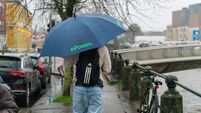Gaelforce of nature
Looking at it now, the triathlon was a “clean” sport — “predictable, precise, calculated”. Adventure racing wasn’t. In navigating the 67km Connemara course, she had to run through bogs and mountain paths, kayak across a fjord, cycle along dirt tracks and climb Croagh Patrick.
How did she feel when she crossed the line? “Wrecked.”
What did she think of the course? “Torture.”
Would she be back the following year? “Definitely.”
Nearly 3,000 others would join her, helping make it the biggest one-day adventure race in Europe, which is some feat, since adventure races, like triathlons, are popping up all over the country and on the continent. A phenomenon, a revolution, is taking place. Mainstream sport can be so restrictive; when you can train, who your coach is, whether he’ll pick and play you, whether you’ll win, what money you make, what age you are. In adventure racing, all those constraints fade away.
That freedom, or as he puts it, “that sense of wildness”, has always appealed to Jamie Young.
It’s why he sailed across the Atlantic alone at 24; how he came to this heavenly spot in Connemara back in the late ’70s to found what is now Ireland’s longest-serving adventure centre; and why he now organises the kind of adventure races which he used to take part in and win himself.
He was born in Cullybackey, a small rural village a few miles outside Ballymena before his family moved to Devon. Mainstream sports did little for him and when he left school, working in an office for a crane-hire company did even less.
“I suppose,” he smiles softly, “I was always a bit what you might call ‘alternative’, whatever that means.”
So he headed for the north-west highlands of Scotland to work as an instructor for John Ridgway at his School of Adventure, one of the first of its kind in Britain.
It was a place for adventure, all right. Ridgway was a charismatic retired paratrooper who’d have his foot soldiers up at 6.30 in the morning, running through the woods and waters around his camp, then allow them to be still up at 2.30 the following morning drinking and sometimes fighting with the local fishermen. “It was mad,” says Young. “You had to get a boat across to where we lived. We were in the middle of nowhere.”
The year before he founded his adventure camp, Ridgway had attempted to become the first person to sail single-handed non-stop around the world before he retired in Brazil, but it would not deter his thirst for challenges. In 1974 his family holiday would consist of trying to sail a 32-foot boat from Scotland to the Cape Verde Islands and back. On board were his seven-year-old daughter, his wife and three of his camp instructors, including a 22-year-old Young.
What they saw will stay with them forever: killer whales floating past their bow, docking in Madeira to walk across a 5,000 foot volcanic plateau; the West African coastline where the desert stretches down into the sea; and then, when they were just off the coast of Connemara, the time they stared death itself in the eye. They would all live to tell the tale, with Ridgway even penning a book about the experience called Storm Passage, but Young’s account, in keeping with his even-tempered personality, is free of any melodrama.
“The Atlantic is as rough as anywhere in the world,” he says with his magnificent Peter O’Toole-like Anglo-Irish accent that amazingly hasn’t been used yet as a voiceover. “When you’re out there, it’s not like a wave on the seashore; it’s a big huge swell. We got caught on one of those breaking waves, so it broke on top of the boat and started to fill the boat up.”
What he remembers most is the cold of the freezing Atlantic drenching him. And the noise, the shrieking of the wind. “That’s what overrides your senses. That noise doesn’t just build up in an hour, it usually takes awhile to build up.”
But all that was peripheral, irrelevant even. The first thing he did was quickly change his clothing, help a colleague off the floor who had been suffering from seasickness and then start rapidly pumping out the water.
“Well,” he smiles, “they say the best pump in the world is a frightened man! But when things get exciting is actually the moment you mustn’t get excited. That’s the worst thing you can do. You don’t go off on trips like that without some expectation that things could get bad. And if you’re not prepared to live with that expectation then you shouldn’t really go out there. Instead you try and prepare the boat and yourself and everything else for those expectations.”
In a way, for a spirit like Young, you’re never more alive than when you’re brushing with death. The rest of us might pray to the heavens, promising we’d do anything to just get out of that fix and never try an escapade like it again, but for Young, seeking the next adventure is the real fix. It’s what he loved about ErnestShackleton, who happened to die doing what he loved.
“I can understand that need he had. The thing about Shackleton which isn’t talked about much is that he never could fit back that well into society as it was known and is known.
“It’s very difficult. If you go off and do stuff like he did, to make that leap and live that life and then go back to ‘normality’. When you’re out doing something which is as challenging as that, all of your emotions are heightened, higher than you normally would get in any other activity. Once you’ve stretched that envelope, you don’t fit back into it.”
And so, two years after that brush with death, Young set off alone to sail across the Atlantic. In 1976 he was one of 125 people who attempted to make it from Plymouth in England all the way to Newport, Rhode Island. Fifty of them quit a few days into the trip but whenever Young had any doubts, he was past the point of no return. He would be among the first 25 to make it all the way across, as well as being the youngest. Four days later he turned around and sailed home again. It was all about the proverbial journey, not the destination.
“I thought it was magical, being able to sail off on your own. There was no GPS in those days and my grasp of astronavigation was very basic but I had a book with me and once I got past Ireland I had to work it out. So I did that by measuring the angle of heavenly bodies like the sun and the moon.
“When you’re 24, the world is your oyster. Any obstacle put in your way, you just work your way around it. But when people talk about you beating the environment, I don’t agree with them. You’re let go out of it at the end of it. You don’t beat it. If anything it brings to light that you’re just a very small part of all this.”
The real challenge is your mind. A lot of people can’t live with themselves and themselves alone for those proverbial 40 days and 40 nights. One of the most testing of times is when it is completely calm, because you and the boat are just stuck there for hours upon end. Some can’t stick it and their frustration translates into panic. “You’ve just got to steady down,” says Young, “and keep calm.”
You learn to catnap for quarter of an hour, half an hour, maybe a full hour at tops, and then suddenly stir as your sixth sense tells you it’s getting windier or the boat might be in the path of another. “But if you’re worried about other boats, you’re in the wrong place. You just have to accept that there are other boats at sea but it’s rare that you’re on collision course with them. The sea is like a road network, it has its motorways and if you learn where to stay off them, you’ll meet less traffic.”
Over the years and decades he has continued to seek out challenges and adventures. He would retrace Shackleton and Tom Crean’s voyage to and crossing of South Georgia, taking a boat on a Russian icebreaker to King George Island before rowing across to Elephant Island, and later sailing across the Scotia Sea.
“That was an extreme feat in a small boat — which we’d discover!” smiles Young in that understated way of his. “We had a sea anchor but the anchor wore through and we were just sitting sideways onto the waves. Eventually one came and just turned the boat upside down. You braced yourself for the worst that time. But eventually it became upright again.”
One of the biggest challenges of the lot was trying to set up his own adventure centre along the lines of Ridgway’s. Ireland in the early ’80s, as he puts it, was “miserable”. There was only one adventure centre in the whole country (which has long closed). He first looked at a site in West Cork, around Roaring Water Bay, but it got knocked back. Then he came across a spot a few miles outside Lennane in Galway. It was located at the foot of the Maam Turks, overlooking Killary Harbour out to Inishturk. It was a view that would take the breath away so Young decided to take the gamble. It meant knocking on a lot of doors and shipping a lot of weird looks but eventually he got the lease of some land and started converting cowsheds into hostels.
The locals didn’t know what to make of Young and his wife and their kids at first. They were a bit, well, alternative, because, well, they didn’t go to church. Today the Youngs are part of the community, the local church is a converted holiday home and Killary Adventure Centre is one of the most thriving centres of its kind in the country.
It’s seen its share of characters. When a certain 2FM presenter went from being known as Gerry Ryan to ‘Lambo’ Ryan, it was under the eye of Young, who supervised that survivor adventure on the Gay Byrne Show.
“That was a crazy time. We had to stop people turning up with loaves of bread to feed them. We had to keep the route secret otherwise you’d have crowds of people turning out looking to give them food. I don’t think RTÉ fully grasped how huge it was. We tried to persuade them many times to make it into a TV programme but they wouldn’t go for it. Then Philip Kampf, the same researcher on that Gay Byrne Show, was over in America and met Mark Burnett and sold him the idea of Survivor. It became a worldwide franchise. Did we get a cut? I wish! I think Philip wishes he did as well!”
There have been other successful ventures and adventures for each of them though. Kampf is the producer of shows such as Operation Transformation, while a brainchild of Young’s has had a similarly positive impact on the lives and wellbeing of thousands. In the early ’80s Young competed in a series of adventure races, including one down in Dingle which he won. Then they faded away. In the middle of the last decade he felt Killary and its surroundings was ideally suited to stage one. Just over 160 people competed in the first in 2006. Last year close to 3,000 took part. An idea has become an industry. This year it has expanded to a whole series of events, starting with a trail run and sea kayak in Connemara, followed by a 9km night run from Bray to Greystones. In June there’ll be a Gaelforce North, through the spectacular Glenveagh National Park in Donegal.
Among those working for Gaelforce — and indeed Killary Adventures — is his daughter, Ciara. As a teenager she swore the big lights would be for her. It was only when she travelled the world for five years that she discovered one of its treasures was literally right on her doorstep. She’s not particularly religious herself but if there is a man above, then Connemara is God’s country.
In August though, it’ll feel hellish in God’s country for some, at least until they cross that finish line. Then a little heaven will appear. “If you stand there at that finish line of the Gaelforce West, you watch people fall over, exhausted but elated,” she says. “And if you were to ask them right there and then would they do it again next year, they’d say no way. And yet I’ll guarantee you, they’ll be back to do it again. It’s an incredible feeling you experience that you can only get by doing it again.”
Her dad can’t do it anymore; at 60, his knees don’t allow him, but he still cycles three times a week, and still yearns for the next challenge. This year he’s looking at the Round Rockall Race, a challenge he first attempted back in ’76.
Always over the mountains, mountains. Once you’ve stretched the envelope, you can’t fit back in.











